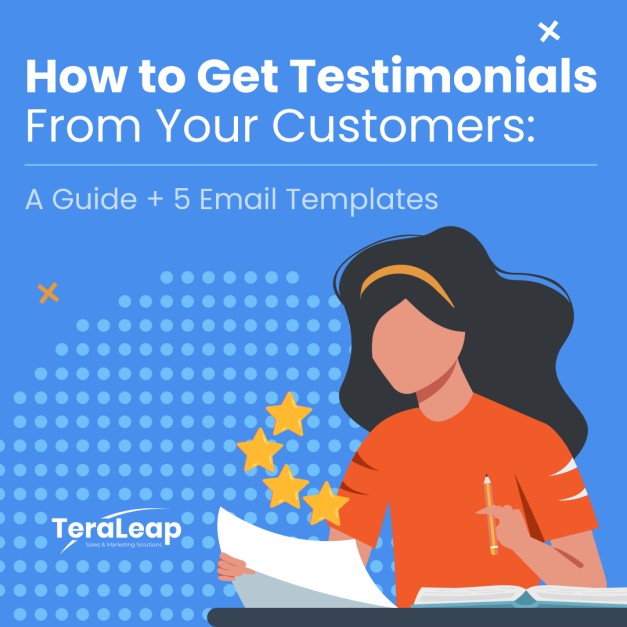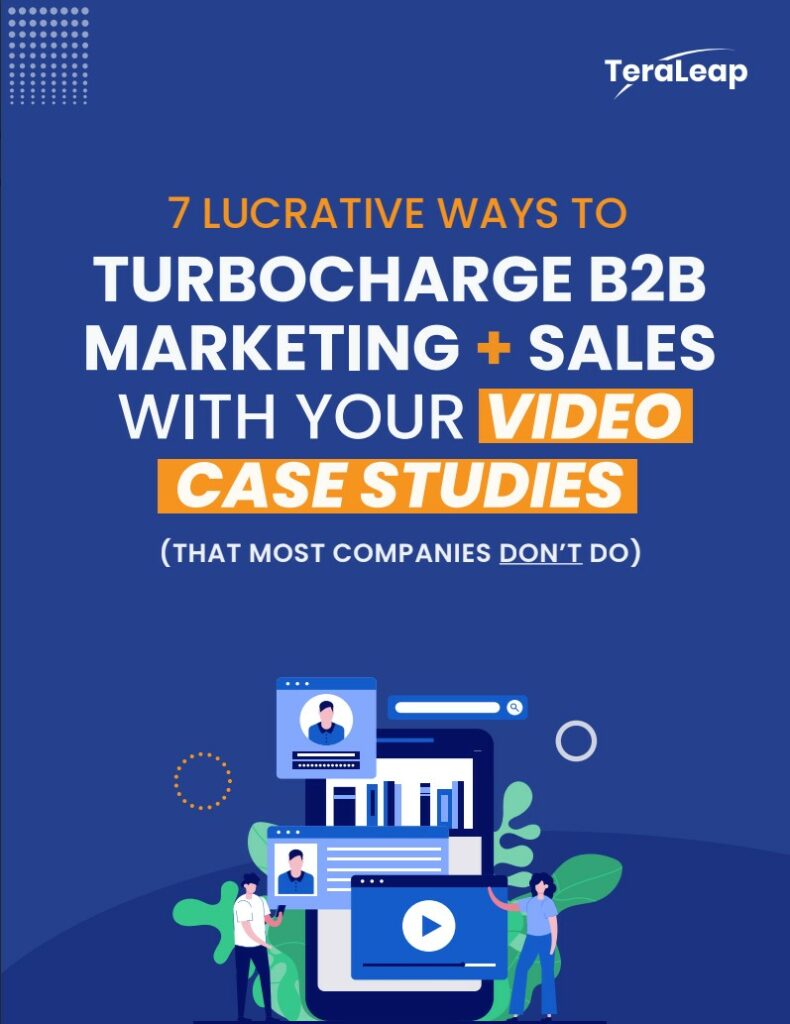Who this guide is for: People who want to learn the fundamentals of creating customer advocates.
Already bagging customer advocates? Sign up for Part 2: How to Leverage Social Proof to Grow Faster now to discover exactly how B2B companies are using customer advocates to increase conversions and shorten the sales cycle.
Imagine your company’s CRM system is outdated and inefficient. You’re looking for a new one, but you’re not sure which one to choose.
A colleague recommends software that they’ve been using at their company. They say it’s been a game-changer for them, and they’re confident it would be a good fit for your company too.
At the same time, you receive an email from a CRM software company that’s trying to sell you their product. They claim their CRM is the best on the market, and they offer a free trial so you can try it out for yourself.
Which CRM system do you choose?
If you’re like most people, you’ll choose the one your colleague recommended. Why? Most people choose products that are recommended by someone else they feel they can trust, even if that person is someone online.
That’s where customer advocates come in. Customer advocates are people who have used your product or service and love it so much that they’re willing to recommend it to others. They become the trusted people who recommend products they love, and it’s powerful when the customers are advocating for your brand.
Customer advocates are potentially the single greatest marketing resource your company has.
That probably sounds like an exaggeration.
It’s not. And we have the data to prove it.
Did you know that by increasing your customer advocates by just 12% you can, on average, double your revenue?
In fact, according to a Nielsen study, the top two most trusted sources of advertising by far come from customer advocates:
Why are testimonials from advocates so effective? Because 88% of consumers trust online reviews as much as personal recommendations.
That stat is so unbelievable it bears repeating – almost 9/10 people treat testimonials like personal recommendations.
And isn’t that every marketer’s dream superpower – to be able to impact prospects like they’re close friends?
Here’s the good news – if you have happy customers that superpower is already yours.
“That’s great,” we hear you say. “But how do I actually create more customer advocates? Or make use of the ones I already have?”
We’ve got you covered.
We interviewed a handful of the great SaaS founders and marketing leaders that we’ve worked with here at Teraleap to get their insights on customer advocacy. The following guide showcases 7 of the best methods for creating and leveraging customer advocates, alongside the practical wisdom kindly shared by our fantastic clients.
What Is a Customer Advocate?
In simple terms, customer advocates are customers who are positively passionate about your company. They think of your company as a force of good in their lives, and they want to tell other people about you because, gosh, you’re just the best.
Very often, customer advocates will come to you; other times you might reach out to repeat customers who you think would make a great advocate.
Many companies will set up a formal advocacy program where the customer advocates will regularly promote your company (maybe in exchange for free products).
We’ll dive into more details about what customer advocates do a little later on.
An Important Distinction:
Before we dive in, let’s take a second to clarify what we’re talking about. There’s a lot of confusion online about these two ideas.
So, customer advocacy is a vital component of creating customer advocates.
Got it? Let’s dig in.
The Why Of Customer Advocates:
Customer advocates are much more likely to:
- Accept mistakes made by your company
- Promote you to friends and family
- Spend more with your company
- Give testimonials and reviews
It’s like you’re a close friend they admire. They feel good when they think about you, and they want to share that.
Unfortunately – just like those real life friendships – there’s no single switch you can flick that will turn a customer into an advocate.
Even when you ask a customer to be an advocate, that relationship will require solid groundwork. You can’t just expect a customer to advocate for you.
Instead, you create customer advocates when you stand out from the crowd across every stage of your process, when you genuinely impact a customer’s life, and when you create trust with authentic communication.
In other words, you create customer advocates by developing an uncommonly satisfying, personal relationship with your customers.
To do that, your company needs two ingredients.
Two Ingredients:
Ingredient 1: Great Offering
This should go without saying.
No matter how good the rest of your processes are, if your product or service doesn’t satisfy your customers they’ll never become advocates. Your offering is the foundation that your House of Advocacy is built on, and those foundations need to be rock-solid.
Ingredient 2: Personal Connection
This is where the bulk of the work needs to be done. The personal connection to your customers is what will transform them into brand advocates.
As we’ll see, this is a multifaceted process – but don’t despair! A great personal connection all boils down to one thing: Considering and improving your customer’s experience. Even working on just a few of these approaches can considerably improve the core processes that create advocates.
Building Brand Advocates
So let’s dive into how to build advocates. We have six great steps so that you can get started!
1. Identify Potential Advocates
There’s wisdom in identifying customers that are already advocates before you work on creating more. Why? Because leveraging them will help you to bring in more clients, and therefore, more advocates.
Kind of like a perpetual advocate machine.
Reaching out to advocates enables you to create compelling testimonials and reviews that persuade prospects across your funnel.
But even better than that, those discussions will give you powerful insights into what your advocates love (or don’t) about your company. That data is invaluable in planning how to spend your resources for converting future customers into advocates.
| “We ask customers every three months if they would recommend us to others.” Dennis Looijenga, Head of Customer Marketing, Foleon |
But how do you do it?
The easiest way of identifying potential advocates is from customer surveys using a single, simple question:
Rate your satisfaction from 1-10
Those who answer 9 or 10 are primed to become customer advocates, if they aren’t already. These are customers who love your company. They’re primed to support you if you support them. These customers should get a disproportionate share of your company’s resources to keep them happy, we’ll cover how you can do that later in the guide.
One last thing, supercharge this process by adding an additional question after they have given a rating:
Why did you give that rating?
By asking for the details of their decision, you’re going to uncover mountains of priceless qualitative information on your customers. The answers you get here are easily worth as much as your customer advocates in building a business that resonates with your market.
Most companies use tools built for the purpose, like Net Promoter Scoring (NPS). Here’s what Dennis Looijenga, Head Of Marketing at Foleon, says about their process using NPS:
Based on those answers, we’ll see which users could be advocates for us. Then we work together with our customer success team (CS) to identify the best ones, see if they have a story to tell, if they’re seeing results with our platform, and if it’s something that they would be willing to talk about. And once we have that list, we’ll start looking at firmographics. Which of our customers have the right profile? Do they match our ideal customer profile? When we combine that data with the NPS, we have a pretty small list of customers that might be willing to be advocates for us.
We’ll come up with an offer so we get something but they also get something in return. We usually do that by giving away swag, because our customers love wearing swag, which is really cool.
Then we start reaching out to customers and offering those incentives in return for doing testimonials for us.”
Dennis Looijenga
Head Of Marketing | Foleon
Pro Tip: The folks at Foleon use Vitally.io to track and measure their customer satisfaction. Vitally is a customer success platform that provides analytics, alerts, automation, and engagement tools to help companies provide personalized customer success at scale.
Disclaimer: We’ve worked with Vitally too! They’ve actually contributed to this guide, you’ll hear from their Head of Growth momentarily.
2. Gather Testimonials
When you’ve identified those potential customer advocates, the best way to be proactive in using them is to ask for testimonials, like Dennis Looijenga does for Foleon.
Why are testimonials important? A study by Big Commerce showed:
- 92% of consumers read online reviews and testimonials when considering a purchase
- When a consumer interacts with your review, they are 58% more likely to convert
So testimonials are a key part of the buying process for customers. Whether that’s written or video, they can be used at every stage of the funnel to build trust.
| “Often, your customers are one of the more immediate ways you can build trust with prospects who really just have your word to go on.” – William Wickey, Head Of Growth, Vitally |
A great side benefit here is that by reaching out to customers you’ve identified as advocates only further cements the idea in their mind that you’re a great company that cares about its customers.
In fact, a study published by Harvard Business Review shows that customers who are surveyed are:
- More than three times as likely to have opened an account
- Less than half as likely to have defected to a competitor
- And were more profitable than customers who hadn’t been surveyed.
Here’s what William Wickey, Head Of Growth at Vitally has to say about testimonials:
Especially when you’re a smaller or younger company – you’re building trust from the ground up. Often, your customers are one of the more immediate ways you can build trust with prospects who really just have your word to go on – because you’re new and getting established in the market. So existing customers are one of your most valuable assets as a young and scaling company.”
William Wickey
Head Of Growth | Vitally
3. Encourage Repeat Business
Let’s get back to how to actually create more customer advocates, now that we’re making the most of the ones we already have.
One powerful driver of brand loyalty is repeat purchases. A study by Yotpo has shown that for almost 40% of buyers it takes more than five purchases to consider themselves brand loyal:
Of course, there’s already a financial motivation to increase revenue through repeat purchases so this makes a compelling case that they are overlooked at your peril.
But what else is necessary to keep customers loyal? Luckily, the Yotpo folks asked their respondents exactly that:
- 64% need fair pricing
- 61.3% need free shipping
- 57.3% need online reviews
- 71% need to be rewarded for their brand loyalty with perks like discounts
These could be considered the foundations of good customer service, so hopefully you’re already doing some of them. They’re the kinds of small touches that add up to a standout experience in your customers’ minds.
And speaking of customer service…
4. Improve Customer Service
Customer service – just like your product – is a vital ingredient to creating customer advocates. In fact, it might be just as equally valuable. But just how vital is great customer service to customer advocacy?
- 68% of consumers say they are willing to pay more for products and services from a brand known to offer good customer service experiences.
- For 86% of respondents, great customer service turns one-time customers into long-term brand advocates.
- 93% of customers are likely to make repeat purchases with companies who offer excellent customer service.
That’s a compelling argument to make customer service a top priority.
Great customer service can even shield you from mistakes. Statistics show that if the company’s customer service is excellent, 78% of consumers will do business with them again after the mistake.
So by growing your number of advocates with great customer service you’re also protecting your company’s image and increasing revenue from all classes of customer.
Here’s Dennis Looijenga on customer service for SaaS:
We need to convince them every time that this is worth paying for.
We do everything we can to be customer centric, to provide the best level of service. And that also means that by doing that we allow ourselves also to branch out to do customer advocacy, because we’re already doing so much for the customer it’s natural for them to also be willing to advocate for us.”
Dennis Looijenga
Head Of Marketing | Foleon
5. Offer Surprises
Studies have shown that when we receive unexpected rewards, areas of the brain connected to behavior development are more stimulated than if the reward had been expected.
Translation? When rewarded unexpectedly we feel better than if we had expected it.
You’ve probably found this is true in your own experience – surprise gifts from loved ones are often more impactful than those we know are coming, like on birthdays.
All of this means one thing for our customer advocacy approach – by rewarding customers unexpectedly we’ll increase the likelihood of them continuing to purchase from us.
And as we saw in point 3 – repeat business builds loyalty.
Here’s Darren Chait, co-founder and COO, of Hugo on rewarding the customer in exchange for testimonials and reviews:
In some cases, when we’ve been closing deals, we’ll put that in the contract. Not that you ever gonna go and enforce it if someone really doesn’t want to do it. But again, if we offer a discount, it’s a tit for tat. It’s an expectation from their perspective, rather than a favor, and it really helps getting people to say Sure. Happy to do it”
Darren Chait
COO | Hugo
* One popular option is Tremendous.com. They help companies incentivize customer behavior no matter their location – it gives your customers options based on where they live – useful if your customers are in different countries. Alyce.com is another option.
6. Focus On The Customer Experience
Beyond your customer service team, your customers are interacting with your website, emails, and social media – all of which are important components of your customers’ experience.
Remember, 68% of consumers say they are willing to pay more for products and services from a brand known to offer good customer service experiences.
Like so many aspects of customer advocacy, this isn’t just a matter of smoothing the customer journey for their benefit alone – it will directly impact your bottom line.
Simple return policies, great UX/UI on your web and mobile fronts, email updates, fast and reliable customer service: All aspects of the user journey should be a pleasure (or at least not a pain) to use.
7. Think Long Term
It turns out that customer advocacy is not a quick gimmick. It’s a long-term approach that yields incredible ROI: According to one study, increasing customer retention rates by just 5% can increase profits by as much as 95%.
But some of these changes may not immediately yield you customer advocates. Building a relationship with your customers, just like any relationship, takes time and effort.
You can’t make a customer love and trust you in a single day or experience.
But by putting your customer’s experience and needs at the forefront of your decision making, you will slowly improve your relationship with your customer base.
And some greater portion of those customers will become advocates that you can then leverage for testimonials and reviews. Not to mention the promotion work they do to their friends and family, which is your best source of passive word of mouth advertising.
Darren Chait, co-founder and COO, of Hugo on the impact of advocates’ testimonials:
When we look at the data on how people are navigating that page, it’s not that they’ve gone and played every video. But they have seen a bunch of faces, from lots of great companies, with a big play button on them that shows you have real customers, real humans, who love your product and want to tell their story.” And that says it all. That’s why we believe that it’s an absolutely critical part of our funnel.”
Darren Chait
COO | Hugo
Summary:
Customer advocacy isn’t easy. If it was, everyone would be doing it because the results are insane!
Thanks to the challenge, you have the opportunity to stand out from the crowd.
But customer advocacy can be boiled down to one simple idea – obsess over your customer’s experience.
Not over KPIs or cold figures and stats.
But over the beating heart of what matters to them.
To do that you only need to talk to them. Regularly. Because they’re both the problem and the solution – they know what they need.
By focusing on solving your customer’s problems and creating the best possible experience for them, you’ll automatically build a culture that your customers relate to.
You’ll be the company that just “gets it”.
And your customers won’t be able to shut up about you.
Enjoyed part 1 of our Customer Advocacy Mega Guide? Click here now to sign up for part 2, where we show you exactly how to leverage those testimonials and reviews for:
- More conversions
- Faster revenue growth
- And shorter sales cycles
Part 2 will be released in the coming weeks, sign up now to secure your copy.
Want to make the most of your customer advocates? Video testimonials help you close more sales, faster. Click here to discover how our clients have sold better with video testimonials, or click here to schedule a demo right now.




